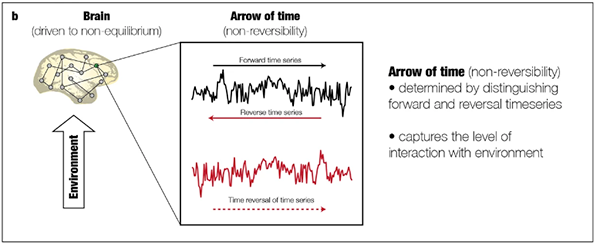- Research News
The second law of thermodynamics inspires the study of the human consciousness
15 August 2022
Researchers of the Human Brain Project have published a study using the principles of the second law of thermodynamics to understand, characterise and model different states of the brain.

A key idea of thermodynamics has inspired a new method to better understand the changes in different states of the brain. HBP researchers at Pompeu Fabra University in Barcelona in collaboration with universities in Argentina, Australia, China, Europe and the United Kingdom have used a new framework to find precise signatures of three different brain states: awake, deep sleep and anaesthesia.
“For many years, our group has been studying how the dynamics of the brain change in different states, for example, between sleep and wakefulness and active cognitive activity, or during a coma, or in patients with neurological diseases,” explains Gustavo Deco, group director and ICREA researcher. “The underlying idea is that the brain works like an orchestra, with a conductor and leaders of each section (woodwinds, strings, percussion, etc.) and depending on our status, these hierarchies change and transform, and this is when we manage to distinguish things. A hierarchical system is where there are one or more zones that take the baton, that conduct other areas.”
These changes can be quantified by measuring how they are functionally connected to each brain state. In the study published in the journal Communications Biology, the researchers quantified this hierarchy, not only by measuring the interactions between the various parts of the brain using a technique called fMRI (Functional Magnetic Resonance Imaging), which shows brain activity, but also using a method inspired by the second law of thermodynamics, which says that a system tends to move from ordered to more random behaviour with time.
The measure of this level of disorder is called “entropy”. If an irreversible process occurs in a system, the entropy of the system always increases. Conversely, in processes that are reversible, there is no change in entropy.
An example of an irreversible process, or one with increasing entropy, is a glass bottle being broken. If a breaking glass is filmed, and the video is played backwards, it would be obvious that the video was on reverse. That’s because the probability of shattered glass coming together to form a bottle is incredibly small. In this case, if the video is played forwards or backwards, it would be easy to know where we find ourselves, before or after the glass breaks, for example.

The key idea of thermodynamics is used to extract the arrow of time in brain signals to capture the level of interaction between the brain and the environment. Source: authors’ own.
In contrast, a process where entropy does not increase, or a reversible one, can be illustrated by a video of a game of billiards – at the moment at which two balls collide and rebound away from each other. Since playing the video either forwards or backwards provides almost identical images, we cannot distinguish at which point we are.
“By quantifying the relationships between different parts of the brain, symmetry is broken,” Deco explains. “If I move the series of signals backwards and forwards, and compare them as I did with the films, I will be able to know which type of system it is. A non-reversible one is a hierarchical system, while a reversible one is not hierarchical.”
By applying this principle, the researchers observed that the technique generates a good biomarker of brain consciousness. In humans, there are differences between resting state and wakefulness and when we perform cognitive tasks, which can be seen on fMRI data. When the researchers applied the novel framework to a large-scale human fMRI dataset, they saw that, as we perform more cognitive tasks, we have more non-reversibility, that is, the system is more hierarchical, Deco explains. “On the contrary, in unconscious states, non-reversibility decreases, that is, the system is less hierarchical,” he continues. “This is a very good biomarker, since it is very sensitive, and tells us that there is a mechanism behind it. This serves very well to the classification of the different brain states, especially those in which there is no clear consensus, like coma.”
This might eventually have a practical application for patient care, as the classification of brain states helps define medical treatments and expectations. Having a good biomarker that characterises any type of neuropsychiatric disease, cerebrovascular accident, heart attack and even depression is the first step. The next step would be to put this biomarker into a computer model. “Then the in silico model must be used to test all the perturbations that are possible, in an individualized way, to determine the best plan of action to treat each patient. This type of approach is of great translational interest, that is, for applying the results of this basic research to the industry”, he concludes.
Reference article:
Deco, G., Sanz Perl, I., Bocaccio, H. et al. The INSIDEOUT framework provides precise signatures of the balance of intrinsic and extrinsic dynamics in brain states. Commun Biol 5, 572 (2022). https://doi.org/10.1038/s42003-022-03505-7
Original Press Release by UPF Barcelona



